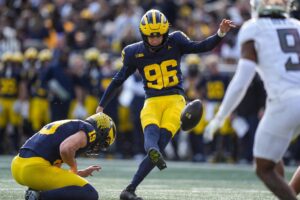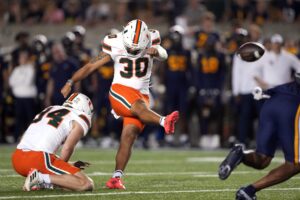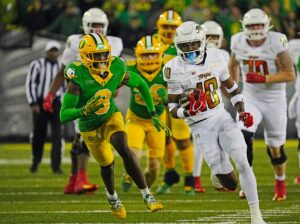The Big Ten Conference released upcoming football opponents for the next five seasons. The expanded 18-team conference had to reshuffle the cards after the announcement of Washington and Oregon joining beginning in 2024. With that, the Big Ten will do away with divisions and play a nine-game conference schedule in a model called “Flex Protect XVIII.” In this new scheduling model, each team in the conference will play every other program at least twice, but no more than three times, in a five-year window. This will allow for each program to play a home and an away game against everyone over five seasons.
In addition to this approach, there are 18 protected rivalries. These protected matchups will happen every season, with the remainder of their matchups rotating on a year-to-year basis. Iowa is the only school in the Big Ten with three protected rivalries. Every year, Iowa will play Minnesota, Nebraska, and Wisconsin. The other six opponents will rotate on a yearly basis. Here’s what the schedule will look like for the Hawkeyes through the 2028 season.
Iowa’s 2024 Schedule
Next year, Iowa has four home conference games, and five on the road. The Hawkeyes will host Nebraska, Northwestern, Wisconsin, and Washington. The Huskies last played in Iowa City in 1964 at Iowa Stadium. That will make it exactly 60 years since their last trip to what’s now called Kinnick Stadium. Iowa and Washington are 3-3 all-time, with the previous three meetings being in bowl games. The Hawkeyes beat Washington in the Sun Bowl in December of 1995. Washington was victorious in two Rose Bowl Games against Iowa in 1982 and 1991.
On the road, the Hawkeyes will travel to Maryland, Michigan State, Minnesota, Ohio State, and UCLA. It will be Iowa’s first trip back to the Rose Bowl since the 2016 Rose Bowl Game. UCLA leads the all-time series with Iowa 6-3. The most recent meeting was in the 1986 Rose Bowl. That game was much-anticipated after the Hawkeyes spent five weeks of that year ranked number one in the nation. UCLA won the game 45-28, and Iowa finished the season ranked #10 in the AP Poll with a 10-2 record.
Iowa’s 2025 Schedule
In 2025, Iowa will host Indiana, Michigan State, Minnesota, Penn State, and Oregon. The Ducks own a 2-1 record over Iowa all time, with Iowa’s only win back in 1949. The last meeting between these two was in 1994 and resulted in a blow-out Oregon victory. The Ducks will make their first trip to Iowa City since 1989 when they beat Iowa 44-6.
The Hawkeyes will travel to Nebraska, Rutgers, Wisconsin, and USC in 2025. The Trojans were originally scheduled to be a road matchup in 2024, but the reshuffled cards resulted in a trip to the Midwest for USC. In the last meeting, Iowa handed USC a 49-24 loss in the 2019 Holiday Bowl. USC leads the all-time series 7-3 and won the 2003 BCS Orange Bowl 38-17. That year, Iowa missed an invitation to the BCS National Championship Game by one spot in the rankings, finishing the regular season ranked number three in the nation.
Iowa’s 2026 – 2028 Schedule
It’s difficult to speculate how teams will look much beyond two seasons, but Iowa knows its opponents for 2026, 2027, and 2028. In 2026, Iowa will host Nebraska, Ohio State, Purdue, and Wisconsin. The Hawkeyes will travel to Illinois, Michigan, Minnesota, Northwestern, and Washington. It will be Iowa’s first trip to Seattle since the early 1960’s.
In 2027, the Hawkeyes host five conference games that include Maryland, Michigan, Minnesota, USC and UCLA. The Hawkeye Faithful will hope the two Southern California schools make their visits in the back half of the season. The cold weather of Iowa City late in the season could make for a unique setting for a warm-weather program in the heart of Big Ten Country. Iowa will travel to Indiana, Nebraska, Wisconsin, and Oregon in 2027. The Hawkeyes were handed a 40-18 loss in their last trip to Eugene in 1994.
Finally, in 2028, the Hawkeyes will play four conference opponents at home. These include Illinois, Nebraska, Rutgers, and Wisconsin. On the road, Iowa will visit Michigan State, Minnesota, Penn State, Purdue, and USC.
What This Means
For Iowa, the changing conference alignment will have several impacts. For one, it is going to be very difficult to win the conference. But not just because the Big Ten is adding very good football programs. The sheer number of teams competing for two spots makes the challenge tremendous. To win the Big Ten, Iowa will need to finish the regular season with a top-two record in the 18-team league.
The Kirk Ferentz era at Iowa has lasted 25 seasons. In that span, Iowa finished with one of the two best records in conference play four times. The Hawkeyes tied for the conference title in 2002 and 2004. Iowa finished tied for second in 2009. In 2015, Iowa finished the regular season with the best record in the conference and lost in the Big Ten Title Game. Introducing four more, highly competitive teams to the conference will make this challenge very difficult.
Conference expansion will, however, help in recruiting. Right now, Iowa typically stays pretty local when it comes to recruiting the majority of its players. That isn’t likely to change all that much just because of the new Iowa schedule. But adding these four teams in two new parts of the country will allow Iowa to make its presence known in Southern California and in the Pacific Northwest. These are regions that produce several high-caliber players, as well as hundreds of quality three-star athletes. Iowa is not likely to land the highly-touted recruits, but it does open a window for the Hawkeyes to get a look at the three stars of the region. The last west-coast recruit to land at Iowa was Spencer Petras in 2018.
If the coaching staff can bring in some of those three-star, West Coast guys, it can add a new dynamic to the culture of the program. Iowa could very realistically broaden its horizon of developmental recruiting. This change has a chance to dramatically strengthen the program’s culture and even its style of football.







